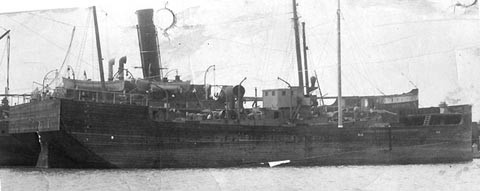Curacao (fuel barge)
1917-1921

(Oil barge: tonnage 1,961.6; length 201'7"; beam 41'4"; draft 13'9" (mean); depth of hold 10'6"; complement 9)
The Navy retained the name carried by this service craft at the time of her acquisition.
Curacao, a non-self-propelled wooden-hulled fuel barge completed in 1917 at Gulfport, Miss., by T. M. Harve Shipbuilding Co., was commandeered at New Orleans, La., by the U.S. Shipping Board for the U.S. Navy, from S. E. L. Madura and Sons, of Curacao, Netherlands West Indies, on 24 September 1917.
Although the Bureau of Construction and Repair, after finding her "not oil tight and ... poorly constructed," had recommended (18 January 1918) that Curacao "be used for some other purpose other than an oil carrier" (two other barges constructed by the same firm having proved "failures"), she was fitted out as a fuel cargo barge at the U.S. Naval Station, New Orleans, and assigned the Identification Number (Id.No.) 2269. Loaded with a cargo of oil at Baton Rouge, La., she got underway, Chief Quartermaster C. Sorenson, in charge, in tow of the U.S. Coast Guard cutter Tallapoosa, on 22 February 1918.
Earmarked for service in the harbor at Hamilton, Bermuda, as a floating base to provide fuel oil to destroyers and submarines there, Curacao was found to be leaky and in poor condition upon her arrival on 4 March 1918. Commander, Detachment 4, Squadron 5, Patrol Force, in Alert, the Station Ship, Bermuda, ordered a board of inspection and survey convened, but before she could be drydocked, seawater contaminated her cargo. Although she had been docked and repaired during May 1918 at the Naval Base at St. George, she was still considered in unsatisfactory condition. Stationed at Agar Island as a storage vessel and by that point known as Fuel-Oil Barge No. 36, she was twice rammed (mostly likely due to weather conditions) by McKee (Destroyer No. 87) on 26 November 1918, suffering damage to an oil tank below the waterline.
Recommended to be returned to the United States following repairs and an inspection, Fuel-Oil Barge No. 36 departed Bermuda on 28 March 1919 in tow of Mohave (Fleet Tug No. 15), and arrived subsequently at Charleston, S.C., and was delivered to the Commandant, 6th Naval District. The need for her services, even given her past history, resulted in her again being placed in serviceable condition, and she continued duty as an oil barge, attached to the Charleston Navy Yard.
Although at some point apparently placed on a sale list, Fuel-Oil Barge No. 36 was withdrawn from same on 9 March 1920, and she was designated as an unnamed fuel-oil barge, YO-36, on 17 July 1920, during the fleet wide reclassification of ships and craft with alphanumerical hull numbers, being deemed "suitable only for yard use." Apparently, however, she reached the end of her usefulness to the Navy by year's end, being ordered appraised for sale on 30 December 1920.
Stricken from the Navy Register on 2 February 1921, the barge was sold to A. Hudson of New York, N.Y., on 5 August 1921.
__________________________________________________________________
T. R. Hasson, 4 April 1962; edited by Robert J. Cressman, 8 January 2008


